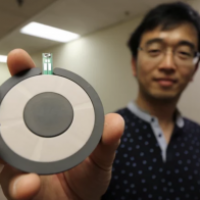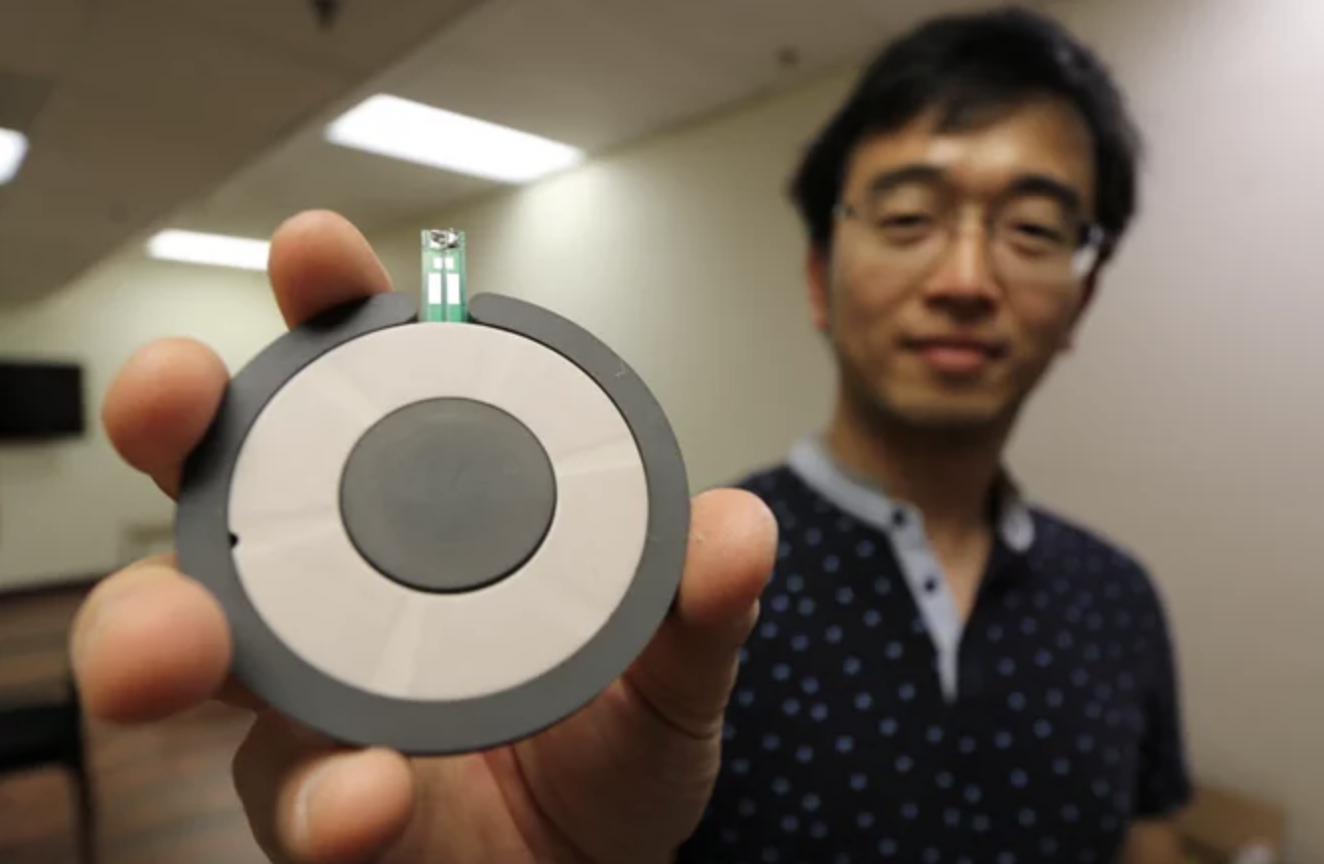

Cofounder Phyo Aung Kyaw holds up the core innovation of Resonant Link—a wireless charger that has five to 10 times lower losses than competing technologies. | PHOTO: Courtesy of Resonant Link
Resonant Link is a venture that is reimagining wireless charging—from untethering medical devices to recharging vehicles on the go.
“We help people rethink what they can do with wireless power,” says Grayson Zulauf, MS ’18, PhD ’20, cofounder and CEO of the company that this spring raised $9.3 million for its breakthrough technology.
On the surface, the Resonant Link charger looks similar to other wireless models on the market: a flat disc of shiny metal and plastic, like a futuristic hockey puck, capable of sending an invisible electromagnetic charge to power-hungry devices.
Inside, the technology is a fundamental leap forward, both in terms of the power electronics—thanks to the Stanford researchers, and the electromagnetic structure—thanks to the Dartmouth researchers.
Wireless charging takes place using magnetic induction between a charging pad and a compatible wireless receiver. The catch is that most wireless chargers can’t transfer power very far—less than 2 inches is common—or very efficiently. Many wireless chargers on the market lose as much as half of the electrical energy en route, as compared to less than 10 percent for chargers that plug directly into devices.
In contrast, Resonant Link can charge across a span of as much as 10 inches and with efficiencies of over 90 percent, rivaling that of plug-in chargers. Importantly, the alignment of the Resonant Link charger is also more forgiving than current wireless technology. The cofounders trace their advance back to collaborating across campuses, and a stroke of serendipity.
Power play
At Stanford, Zulauf spent his PhD in the lab with Juan Rivas-Davila, an associate professor of electrical engineering and leader in high-frequency power electronics. “Juan had this amazing vision of using megahertz frequencies to make power converters smaller, lighter, and more power-dense,” he says.
With support from a TomKat Center research seed grant in 2016, they spent two years carefully analyzing power converters made from wide-bandgap materials, a class of semiconductors that allow devices to become more efficient than their silicon-based counterparts, capable of forceful bursts of energy. By 2018, Zulauf had won a NASA prize for his graduate research and was invited to present his findings at a power electronics conference in Italy.
Meanwhile, across the country at Dartmouth College, Professor Charlie Sullivan’s lab was exploring new shapes for the electromagnetic coil inside of wireless chargers.
Traditional wireless charging antennas are made stronger by twisting braids of insulated copper wire. The smaller the strands of litz wire, as it’s called, the higher the performance—but also the higher the price tag. Most producers are limited to around 100 microns for the strand diameter before the manufacturing costs get untenable.
Sullivan discovered a method to build a wireless charger that completely eliminates the need for litz wire. He gave the technology itself a twist, transforming the coils into a 3-dimensional structure using special foil layers less than 10 microns thick, and allowing the electromagnetic charge to reverberate and echo off of itself, increasing in intensity with less cost.
As luck would have it, Professor Sullivan and researchers from his lab were headed to the very same Italian conference. Soon the engineers hit it off.

The Cofounders (clockwise from left): Grayson Zulauf, MS ’18, PhD ’20; Phyo Aung Kyaw, PhD; Aaron Stein, PhD; Professor Charlie Sullivan.
“We were like, “Hey, maybe we should combine what Professor Rivas-Davila and I have been doing with power electronics with what Professor Sullivan and Aaron and Phyo have been doing in magnetics, and build a full wireless charging station?’”
Which is exactly what happened next.
In 2019, the team applied for an Innovation Transfer Grant from the TomKat Center and built a prototype with results so convincing that the project landed their first commercial client.
Freeing medical devices
With their nascent technology in hand, the researchers asked themselves, “Who cares most about wireless charging?” One answer became clear: People whose lives depend on batteries.
The Resonant Link team learned that implanted medical devices, like pacemakers for the heart, often require surgery to replace the batteries. Others, like insulin pumps for diabetes or ventricular assist devices for heart failure, connect the device to an external power source. This means that patients are left with drivelines, electrical wires trailing from their abdomen or chest, that make daily life difficult and are prone to infection.
In fact, 5 percent of ventricular assist device patients die each year from driveline infections. Having reliable, rechargeable, wireless power could truly be life-altering for patients like these.
“We want to make the next generation of medical implants rechargeable by default,” says Zulauf. “For one of our customers, we solved charging for a product that they’ve wanted to make wireless for over 40 years.”
It’s been a useful proving ground for the startup. Chargers always lose some power as heat, but inside the human body this is problematic, and so the FDA mandates that implanted devices cannot heat surrounding tissue more than 2 degrees Celsius.
“So you have to have very efficient power delivery,” he says. “And these are life-critical devices, and so proving the reliability there is more than enough for every other market.”
Charging ahead
Today Resonant Link has 30 employees from San Francisco to Zurich, with the lab headquarters based in Burlington, Vermont. Their clientele has expanded to include nearly a dozen medical device companies, as well as government agencies, leading car companies, and some of the world’s biggest consumer electronics brands.
In 2022, the venture plans to deploy their technology in the mobility market, starting first with forklifts in warehouses, and later electric vehicles on the open road.
Resonant Link aims to teach electric vehicles how to power nap, so to speak—getting quick, frequent charges of energy for slim batteries—rather than the overnight recharge for bulky batteries that we’re accustomed to today.
This comes with practical advantages—more time in motion—as well as economic and environmental ones. Batteries are expensive. Frequent, rapid charging could reduce battery size and in turn lower the cost of EVs, enabling a faster transition to a fossil fuel-free transportation fleet.
Zulauf says the TomKat Center funding is what laid the runway for their ascent, first the seed grant, and then the innovation transfer.
“From Day 1, the TomKat Center has been promoting exactly what we are now building on a commercial scale,” he says. “It just wouldn’t have happened without them—and that’s not an exaggeration.”
Boundless Charging - TomKat Center for Sustainable Energy - June 1, 2022


